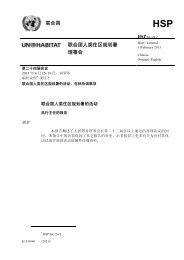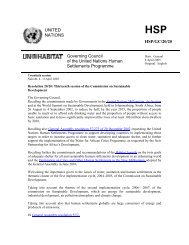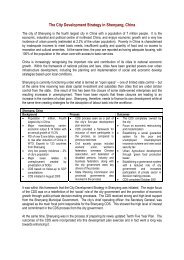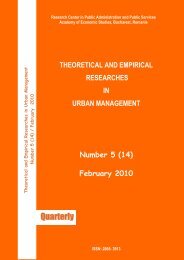Harmonious cities - UN-Habitat
Harmonious cities - UN-Habitat
Harmonious cities - UN-Habitat
Create successful ePaper yourself
Turn your PDF publications into a flip-book with our unique Google optimized e-Paper software.
Perth Lord Mayor Lisa Scaffidi defends the<br />
new plant as one of the first in the world to be<br />
entirely powered by renewable energy, sourcing<br />
electricity from a wind farm.<br />
“We have also began an intensive monitoring<br />
programme to gauge the impact on the<br />
bay in which the studies have so far found<br />
that there will be no adverse ecological effects,”<br />
she confirms.<br />
Spain, with the largest number of desalination<br />
plants outside the Middle East, has also<br />
focused on improving energy efficiency in its<br />
plants. Previously they would use 18kw/h to<br />
produce 1 cubic metre of water. Now, its newest<br />
plant in Barcelona, due to be completed<br />
next year will use only 3kw/h per cubic metre<br />
of water, 45 percent of which will be solar<br />
power.<br />
The fact that there have been no long-term<br />
studies on the environmental impact concerns<br />
Pittock from the WWF. “As with any<br />
relatively new engineering, such as large<br />
dams that grew up in the 1950s, the negatives<br />
become known when it is too late or too expensive<br />
to fix. What we need most is a new<br />
attitude to water not unchecked expansion of<br />
water engineering.”<br />
Other less harmful technologies and water<br />
systems may also lose out to the big promises<br />
of desalination. Melbourne, Australia,<br />
will see one of the largest desalination plants<br />
built on its shores. Already the city provides<br />
tax rebates and statutes that require all new<br />
housing to have either a rainwater tank or<br />
solar hot water system. Many argue now that<br />
these rainwater tanks will be obsolete and<br />
unnecessary after the plant is built, which<br />
will eventually provide up to 150 billion litres<br />
of water a year.<br />
Melbourne University scientist, Peter<br />
Coombes, believes that rainwater tanks have<br />
the potential to provide between 80 billion<br />
and 120 billion litres of water a year for the<br />
city and at a lesser cost.<br />
Although his reports do not say it, their implication<br />
is that an alternative water strategy<br />
could save taxpayers and homebuyers money<br />
by reducing reliance on expensive public water<br />
facilities, such as desalination plants.<br />
“There is a window of opportunity to refocus<br />
Melbourne as a sustainable city, which<br />
includes rainwater harvesting, waste water<br />
recycling and water/energy efficiency and we<br />
cannot lose this chance by pursuing silver<br />
bullets from a narrow economic perspective,”<br />
says Coombes.<br />
Even London, with its wet and rainy image,<br />
has needed to turn to this technology due to<br />
ever increasing pressures on its water supply,<br />
albeit after a lengthy court battle after the exmayor<br />
of London, Ken Livingston opposed it.<br />
Ken Livingston’s argument was that it was<br />
senseless to consume vast amounts of energy<br />
to treat brackish river water when 790<br />
million litres of drinking water is lost everyday<br />
in London due to leaky water pipes. Five<br />
times the amount the plant will produce.<br />
“They (Thames Water) should invest more in<br />
Water<br />
IN-FOCUS<br />
repairing pipes and harvesting rain,” he said.<br />
“There is no need for a desalination plant as<br />
with improved demand, leakage and resource<br />
management, it would be possible to ensure<br />
adequate water supplies for London without<br />
it.”<br />
Despite these concerns, more and more <strong>cities</strong><br />
are increasingly turning to desalination<br />
plants. In California alone some 20 seawater<br />
desalination plants have been proposed, including<br />
a USD 300 million facility near San<br />
Diego.<br />
China, India, and Africa with rapidly growing<br />
middle classes, are building more and<br />
more desalination plants to meet demands<br />
from growing industries and have even moved<br />
into the technological research of plants.<br />
Water-starved Chennai, on India’s southeast<br />
coast, will soon host the country’s largest<br />
desalination plant, where the city’s water<br />
requirements are expected to double by mid-<br />
2031. This year Algeria opened the largest de-<br />
Many new plants are entirely powered by renewable energy Ph o t o © WAt e r Co r P o r A t i o n<br />
salination plant in Africa to provide water to<br />
one million residents in the capital.<br />
Not all plants are designed or limited to<br />
large urban centres. Ksar Ghilène is an isolated<br />
Tunisian village of 300 inhabitants in the<br />
Saharan desert. Drinking water is supplied to<br />
the village through the use of a brackish water<br />
reverse osmosis desalination plant driven<br />
by photovoltaic solar energy. After two years<br />
of operation the plant has successfully produced<br />
more than five million litres of fresh<br />
water. u<br />
u r b a n<br />
November 2008 WORLD 29

















